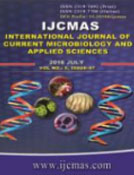


 National Academy of Agricultural Sciences (NAAS)
National Academy of Agricultural Sciences (NAAS)

|
PRINT ISSN : 2319-7692
Online ISSN : 2319-7706 Issues : 12 per year Publisher : Excellent Publishers Email : editorijcmas@gmail.com / submit@ijcmas.com Editor-in-chief: Dr.M.Prakash Index Copernicus ICV 2018: 95.39 NAAS RATING 2020: 5.38 |
The antimicrobial potential of Barleria prionitis Linn. (Aerial parts) were evaluated against common respiratory tract infections causing bacterial and fungal pathogens. The pathogens used in this study were Streptococcus pneumoniae (MTCC 655), Staphylococcus aureus (MTCC 1144), Pseudomonas aeruginosa (MTCC 2474), Streptococcus pyogens (MTCC 442), Haemophillus influenzae (MTCC 3826) and two fungal strains Candida albicans (MTCC 227), Aspergillus niger (MTCC 921). Antibacterial and antifungal activities were determined by Agar well diffusion method, poison food technique, respectively. Erythromycin and fuconazole were used as positive control to establish the sensitivity of bacterial and fungal strains respectively. Methanol (MeOH) extract was found most active followed by ACE, H2O and PET respectively. The maximum inhibition zone was found against S. pneumoniae (19.40±0.64 mm) followed by S. aureus (18.73±0.80 mm), P. aeruginosa (14.98±0.28 mm), S. pyogens (14.2±0.47 mm), H. influenzae (10.11±0.21 mm), and Candia albicans (6.66±32 mm). Minimum inhibitory concentrations (MICs) were observed for MeOH extract between 3.12 to 25 mg/mL against S. pneumoniae, S. pyogens and Candida albicans respectively. The antimicrobial activity of the crude extracts of plant represents a significant outcome for the treatment of respiratory diseases.
 |
 |
 |
 |
 |